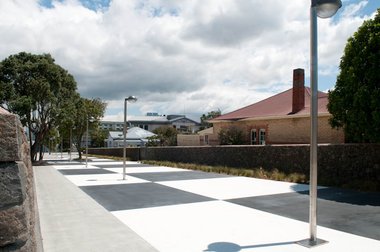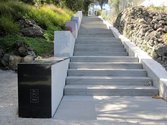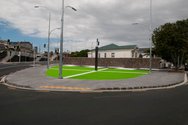John Hurrell – 25 December, 2010
What is amazing about this project is its fastidious detail - all checked and rechecked by Apple. Scoria stone walls have been built by Scottish stone masons so they are impeccably flush; grouting laid with perfect edges; entire houses removed or realigned; footpath curbs redesigned and remoulded. The result is that the walkway with its geometry seems oddly European, as if one is walking into a de Chirico or Uccello painting.
Auckland
Billy Apple
Corner Post
Regular readers will probably realise I live in Kingsland and am delighted to do so. Its location within Auckland makes it easy to get around the various downtown and suburban galleries that interest me, it has two train stations on the western railway line so I can go to either Mt. Albert or Britomart, it is close to St. Lukes (if I ever am desperate enough to want to shop there), and more importantly, of all the Auckland suburbs it seems to be the one most endowed with public art; art that happens to be very good - some courtesy of a charitable trust (notably Jar, the 24 hour gallery you can check out from the footpath), others more recently courtesy of Auckland Council.
Of the latter, there are two public Billy Apple artworks in Kingsland.
One is a basalt, granite and marble staircase that was completed last year to replace a path that descended from the end of George Street down a slope to Onslow Road. It runs past a small patch of bush down to a children’s playground at the bottom, next to the Onslow Road footpath. The work has links in its proportions and balustrade to the staircase Apple designed in 1979 for the Govett-Brewster Art Gallery, and which was purchased as an artwork in 1980.
Going down the staircase are seven basalt landings that are in the 1:1.618 proportions of the self-replicating Golden Section, each followed by five basalt steps. On the left is a low concrete wall and a scoria stone wall above it. On the right are seven granite walls for each of the seven divisions, lined at their fronts and tops with slabs of different coloured, glossy, veined marble.
The other project, The Corner Post, just opened early this month, is much grander. It’s in two parts and was designed for the civic improvements implemented by Auckland Council in anticipation of the coming World Cup. In both sites Apple’s use of the Golden Section is again a dominant feature.
One part is Wairepo Swamp Walk, a pedestrian access way leading from the direction of the Bond St bridge to the entrance of the main stadium. The ground is set in a checkerboard formation of what first glance seem to be alternating black and white concrete squares. Actually they are squares and rectangles, with a plain concrete path running along the lefthand side that consists of the difference between the two - a line of Golden Sections end to end. The same distance out from the central midpoint (i.e. the width of the plain path) Apple has placed a line of streetlights, the poles placed exactly in the centre of each spiralling, infintely regressing rectangular vortex.
The central feature of the other site is The Corner Post itself, the eponymous, enlarged marker post with a rigid but swivelling flag that references those flags you might find on a rugby field. It is on the corner of Walters and Sandringham Roads, and again shows the chequered, but asymmetrical proportions of the Golden Section, mimicking the Wairepo Swamp Walk floor. It’s a highly ambiguous semaphore, referring to car racing as much as rugby (or cricket), and celebrating mathmatics not only as a means of resolving competitive sporting rivalries, but as a science in its own right.
The footpath area is designed to show off a north-south, east-west axis, in the centre of which is positioned an enlarged, square cross-sectioned, stainless steel flag pole, with its latitude and longitude co-ordinates lazercut on its side. Over the walking area around the cross on the ground is a glued layer of fluorescent green granules made of glass.
What is amazing about this project is its fastidious detail - all checked and rechecked by Apple. Scoria stone walls have been built by Scottish stone masons so they are impeccably flush; grouting laid with perfect edges; entire houses removed or realigned; footpath curbs redesigned and remoulded. The result is that the walkway with its geometry seems oddly European, as if one is walking into a de Chirico or Uccello painting. It is a slightly surreal experience that conveys a hyper-acuity and intense awareness of converging perspective, an oddly unnerving sensation repeated by the giant flag pole and dazzling green footpath. An unreal Kingsland that normally one might only dream about.
John Hurrell






 Advertising in this column
Advertising in this column Two Rooms presents a program of residencies and projects
Two Rooms presents a program of residencies and projects



This Discussion has 0 comments.
Comment
Participate
Register to Participate.
Sign in
Sign in to an existing account.